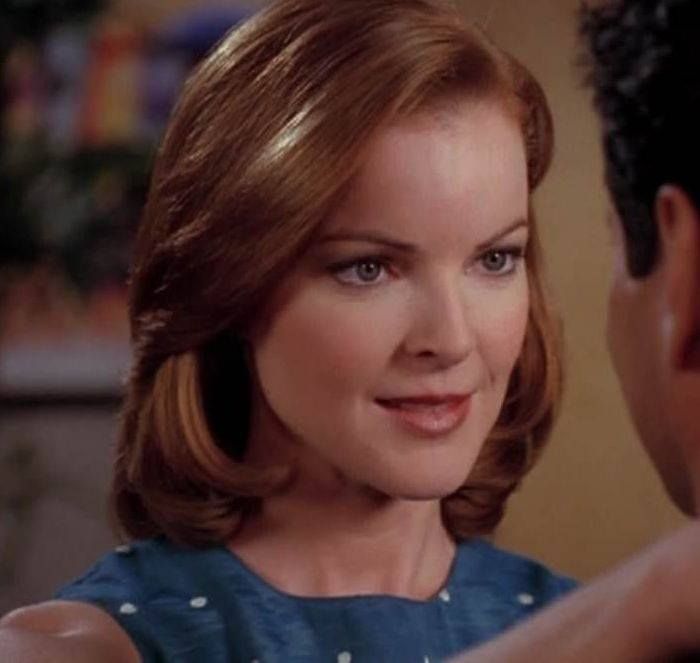Melrose Place first aired in 1992 as a spin-off of the largely popular show Beverly Hills 90210. Beverly Hills 90210 explored the lives of wealthy high schoolers, so a version with twenty-somethings seemed like a natural next step. Both shows were creations of Aaron Spelling, who already found success in the nighttime soap formula. During the first season, the show was episodic and attempted to mimic the tribulations of twenty-somethings but was quickly retooled with the addition of soap veterans Heather Locklear as Amanda Woodward and Marcia Cross as Dr. Kimberly Shaw. Kimberly begins a tumultuous affair with Dr. Michael Mancini. Shortly after ending his marriage to his wife, he proposes to Kimberly right before being injured in a car accident. Kimberly is declared dead, only to reemerge later, her parents leading Michael to believe she was dead so he would leave her alone. In an iconic scene, Kimberly reveals she wears a wig now because of deep scars on her scalp from brain surgery. She swears revenge on Michael, who, not only moved on to relationships with other women but because of the accident, is now unable to have children.
Kimberly’s revenge is based on her desire to have the tenants of femininity denied to her: she can no longer be a wife and mother, and also prohibited her from having a career as a medical doctor. She was the cliché of “having it all.” Kimberly quickly slipped from angry to vengeful to “crazy,” seeing a disheveled older man as a manifestation of her murderous thoughts. The loss of access to feminine institutions has literally driven her crazy. On the other hand, her vengeful nature could be due to her brain injuries, further dismissing her actions. Either interpretation still situates her desires as the form. Furthermore, she is used as a contrast to the perfectly behaved, ultra-feminine Jane Mancini and do-gooder girl next door Alison.
Supplemental reading
In his article, Miklitch discusses Melrose Place’s transformation due to production decisions. It is important to not just consider the show as a text but to also examine the conditions and context as a cultural product. The author explains the various decisions made about the directions of the narrative because of the strong women on the show (Cross as Kimberly as well as Heather Locklear as Amanda). He then uses Raymond Williams’s idea of the structure of feelings to the characters on the show. This leads to a conclusion about the ways in which the show works as a narrative feeling. This is significant because the affect experience while watching soap operas is something that has only been discussed recently. The feelings of watching the show as a phenomenological experience can explain the presence of a villain. This provides one approach to connecting the ways in which the villain is portrayed to create emotional structures of feeling. This is important to the character of Dr. Shaw because according to this article, Kimberly has an excess of feeling, thus making her monstrous.
Modleski, Tania. “The Search for Tomorrow in Today’s Soap Operas.” In Loving with a Vengeance: Mass-Produced Fantasies for Women. New York: Routledge, 2008, pp. 77-101.
Modlieski’s book is significant in the study of feminized mass culture, not only bringing it to relevance but to begin the understand the relationship of audiences to the text. The chapter, “The Search for Tomorrow in Today’s Soap Operas” provides a discussion about the role of the (usually female) villain in soap operas. The archetype is either she is a bad mother, wife, but that the “villainess is able to transform traditional feminine weakness into a source of strength” (87). In this sense, the villainess is rebuking the feminine role and using masculine traits to her advantage. This chapter also expands on the emotional reading that is embedded into the genre. Close-ups of people’s faces and reactions allow for a better connection to how the character is feeling. This is no exception in Melrose Place, as Kimberly Shaw’s character often has solo act-outs expressions of rage, delight, or terror after the person she is talking to leaves the room. The villainess shows the most emotion, creating more connection and humanizing her.
Modlieski also examines “narrative pleasure” as a stigmatized aspect of soap operas. The pleasure derived by women includes both escapist notions as well as pleasure derived from emotional sensibility: “In soap operas, the important thing is that there always be time or a person to consider a remark’s ramifications, time for people to speak and to listen lavishly. Actions and climaxes are only of secondary importance” (98). The Villainess’s actions are only secondary to her feelings and motivations, further delving into her circumstances.
